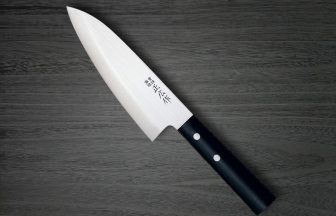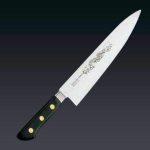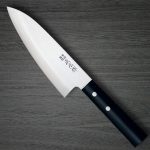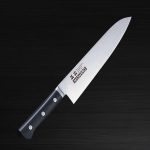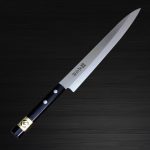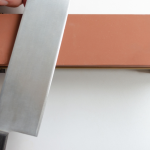img by : https://www.hocho-knife.com/
Japanese cuisine is renowned for its intricacy – the most significant component which marked its fame and global popularity. The use of a Japanese knife essential for the crafting of Japanese delicacies like sushi and sashimi is what diners look for in chefs when dining at a Japanese restaurant or an Omakase restaurant. With this, Japanese knives and their variety serves different purposes and are essential for all food preparation processes.
When it comes to Japanese cuisine, the mastery of the blades is truly essential. The core basic, as well as the foundations of authentic Japanese cuisine have always revolved around the passionate desire to yield the blade with confidence – and even better supported with the understanding of how each culinary art piece is to be crafted. The professional chops, cuts, and slices are critical in the making of numerous Japanese hand-crafted culinary pieces, specifically the world’s most loved Japanese food – sushi. Sushi or the delicately-crafted, thin slices of raw fish or other types of meat topped on Japanese sushi rice, is a world phenomenon to gourmets from different parts of the world. Sashimi, too, is another delicious, mouth-watering Japanese cuisine that warms the hearts of raw fish lovers who enjoy the authentic tastes of exotic rawness and the great blends of meat with extraordinary seasonings master chefs prepare for their signature dishes. As these delicate dishes require extreme patience, understanding, and a true dedication to perfectly run through the intricate processes, sushi is a Japanese cuisine known to be among the most challenging dishes to master. From the selection of fine ingredients to the mastery of the Japanese knife, chefs and professionals in the culinary field have always valued the importance of the techniques and skills essential to perform the perfect, all-kills in the crafting of authentic Japanese cuisine.
Sakai Takayuki Blades
Japanese knives, also known as ‘Wa-Bochos’, are highly crucial in all Japanese cooking processes. As earlier mentioned, the crafting of sushi, specifically, requires extremely good blade skills to perform swift cuts, perfect chops, and thin slices as these ingredients are the essential Japanese food aesthetics that only raises the bar of expectations gourmets have. Japanese knives are required to be extremely sharpened – along with a fine quality handle to support the hands and wrists, further enhancing the performance.
Of all the top Japanese knife brands, Sakai Takayuki ranks among the top three for having the best quality knife with unique forging techniques. Their knives and the level of sharpness are just out of the question – amazing knife models are mostly all of Sakai Takayuki’s. With more than a decade of experience in forging the blades, Sakai Takayuki and his team of highly skilled blacksmiths are always creating beautiful blades to satisfy professionals and even knife collectors from all over the globe. Sakai Takayuki blades are forged to support various kinds of usage ranging from performing multi-tasks to ones used to slice sashimi – the Yanagiba-wabocho.
Sakai Takayuki Seiryu Damascus (Aogami 2 Steel) Japanese Chef’s Kengata-Yanagiba (Sashimi) 270 mm with Saya Sheath is a knife model which performs all kinds of techniques required to craft delicate sashimi pieces, but also a general purpose knife made to perform a wide variety of kitchen tasks. This special, Seiryu series blade features extraordinarily beautiful Damascus patterns, showcasing the beauty of authentic traditions. The blade’s core is made out of the Aogami or Aoko blue paper No.2 steel – made from the Yasugi steel, famous for its extreme hardness as a prime high carbon steel. With highest resistance to damage, Sakai Takayuki Seiryu Damascus (Aogami 2 Steel) Japanese Chef’s Kengata-Yanagiba (Sashimi) 270 mm with Saya Sheath is a knife forged with a special hardness of 61-62 HRC, suitable for extreme uses professionals might need. Its Ebony wood handle is of fine quality, designed well to fit all grasps, while the buffalo top and bottom parts of the handle offers superb durability which is required to excel all kinds of skills. For right-handed users, this knife model is indeed among one of the best single-beveled knives that aid in the enhancing of blade performance.

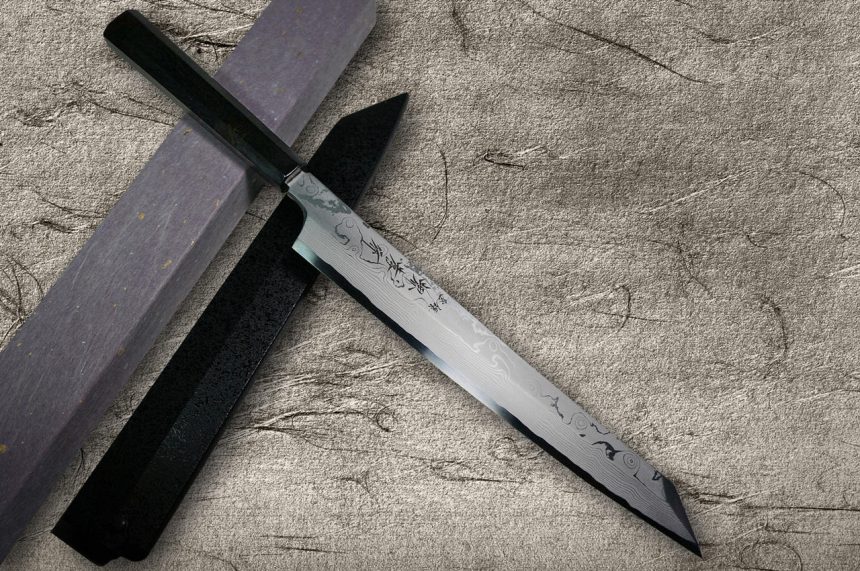

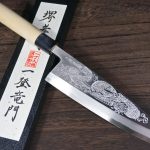
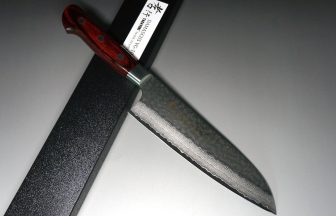
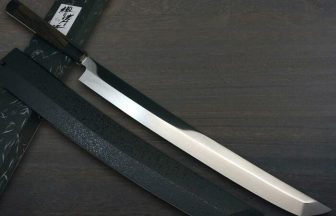

![Sakai Takayuki Non-Stick Coating VG10 Hammered WA KUROKAGE Japanese Chef's Kengata-Gyuto Knife 190mm with Japanese Lacquered Oak Handle [KOUSEKI]](https://chefshuffle.com/wp-content/uploads/2022/11/sakai-takayuki-sakai-takayuki-non-stick-coating-vg10-hammered-wa-kurokage-japanese-chefs-kengata-gyuto-knife-190mm-with-wenge-handle__79954-336x216.jpg)

